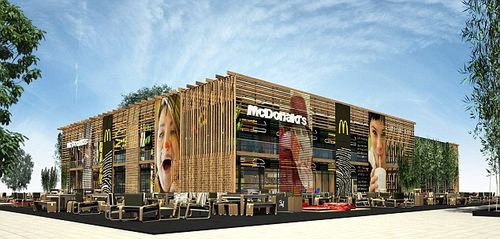
I’m at a payments conference today – and so will finish off the TEDx Wall Street story tomorrow – but wanted to post a quick update for those who are looking at mobile versus proximity payments.
Here are two stories.
The first is about the London Olympics, which will be the first ‘cashless Olympics’ according to Visa.
The major reference story for Visa UK and the Olympics is McDonald’s.
McDonald’s rolled out contactless payments to all their stores on 23rd May 2011, and over half of stores took a contactless payment on the first day of opening and now 90% of them take at least one contactless payment a day.
Since the launch in May, there have been over 1.88 million contactless transactions, worth around £11.2 million, with an average transaction of just under £5 in value.
Just over 3% of all payments are contactless today, with the overall split of payments in McDonald’s being around 70% in cash and 30% by card.
In the Olympic context, McDonald’s are a sponsor and will be opening their flagship restaurant in the village, which will be the world's busiest restaurant …

… the 3,000 square-metre restaurant stretches over two floors and is equivalent to half the length of an American football field. It has 1,500 seats, will employ 470 staff serving around 50,000 Big Macs, 100,000 portions of fries and 30,000 milkshakes during the Games.
All in all, the idea of serving up to 25 people per minute in one store would be impossible to achieve without contactless payments, they claim.
Now I’ve said already that contactless may be a short-lived technology, as proximity payments like Square’s Card Case offer mobile apps for contactless payments.
There are many others out there too, with the oldest being Bump which is now PayPal Bump (and note PayPal have also launched a Square killer).
But one thing we mustn’t forget is that there is one other key alternate for paying that is also contactless, requires no apps and no chips.
Just a camera.
The QR code also offers a great way to pay and, in case you haven’t seen it, this case study of Tesco’s subsidiary Home Plus in South Korea is a fantastic example of how to use QR codes to differentiate and win business.
First, the video is well worth a viewing as it shows you the potential:
Alternatively, read the case study from the Telegraph:
Tesco’s South Korean network of shops, called Home Plus, have grown to become the country’s second-largest supermarket after E-Mart since launching in 1999, but number two is never enough for Tesco. How, they asked themselves, can we become number one?
One way, they reasoned, is to expand their online sales rather than spending a lot of money opening new shops. As South Korea has more than 10 million smartphone users in a population of less than 50 million, it made sense to look at mobile shopping as much as websites for desktops.
Just like everybody else, South Koreans are busy at home and tired after a long day at work so offering the opportunity to shop while doing something else has a lot of value. Tesco settled on commuters waiting for their train: they have time on their hands and the must have jobs, so they’re likely to have money but little time.
Rather than expect them to search through menus labelled with tiny text that says such unattractive things as ‘fish’ or ‘homeware’, they plastered the glass walls of subway stations with pictures of their products, laid out just as they’d be in a traditional shop. The ‘shelves’ featured QR codes - squares filled with a black and white pattern, unique to the product in question, they’re a more versatile successor to the bar code - which could be scanned by the traveller’s mobile phone, building up a shopping basket in the few minutes before the train arrives. If your train comes before your basket is complete, you can carry on shopping without the pictures and codes if you wish.
Deliveries are arranged to arrive in minutes or hours, rather than days, so the groceries will be in the shopper’s kitchen that night and there is no need to wait in to collect them.
The application was developed with Cheil Worldwide, an advertising and online development group.
A great case study and offer.
Chris M Skinner
Chris Skinner is best known as an independent commentator on the financial markets through his blog, TheFinanser.com, as author of the bestselling book Digital Bank, and Chair of the European networking forum the Financial Services Club. He has been voted one of the most influential people in banking by The Financial Brand (as well as one of the best blogs), a FinTech Titan (Next Bank), one of the Fintech Leaders you need to follow (City AM, Deluxe and Jax Finance), as well as one of the Top 40 most influential people in financial technology by the Wall Street Journal's Financial News. To learn more click here...

